All You Need to Know About Commercial Demolition
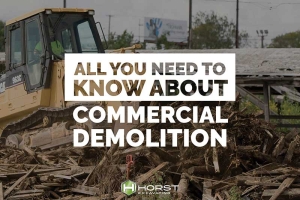
Unless you’re building on a vacant greenfield site, demolition is a fundamental part of the project cycle. Whether demolishing a small portion to allow for renovations or more extensive work to remove something that stands between you and a fresh new building, demolition is a necessary step in most cases. To keep your project moving, you’ll need a trusted demolition contractor that can get things done quickly and safely.
In this blog, we’ll share the information essential for navigating a demolition project. We’ll cover:
- The different types of demolition
- The five steps of a demolition project
- How much building demolition costs
- How you can find a good commercial contractor
The Different Types of Demolition in Construction
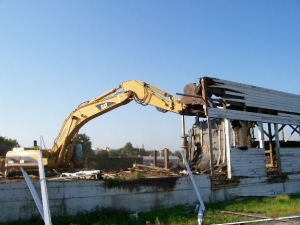 Demolition can range from completely razing a building to just removing interior finishes. Below are the four types of demolition, and an explanation of what each entails.
Demolition can range from completely razing a building to just removing interior finishes. Below are the four types of demolition, and an explanation of what each entails.
Total Demolition
Total demolition requires the removal of an entire building. This is the type of demolition typically done when the existing building serves a completely different purpose from the building you need. For example, a single-resident home vs. a new commercial building. Or an old barn vs. a restaurant. Because the layouts of these buildings are so different, there often isn’t a meaningful way to integrate the existing one into the new one, so starting over is best.
Selective Demolition
Selective or partial demolition is when just a portion of the existing structure is demolished. You may want to consider this approach if part of the existing building is in good shape, fits the needs of your organization, and/or has aesthetic or historical value. Readapting existing spaces can, in some instances, be more affordable than building completely new.For more on renovating vs. building new, check out this article from our sister company, Horst Construction.
Interior Demolition
If the “bones” of the existing building are still in great shape, but the interior isn’t suited to your tastes or needs, an interior demolition may be a good option. In this type of demolition, your team will demolish the building’s interior structure, leaving the exterior of the building as is. It can be a great way to preserve and maintain an attractive historical building and strategically preserve the structural asset.Overall, opting for interior demolition can be a more affordable way to customize a space to your organization’s needs, as opposed to starting from scratch.
Deconstruction
Deconstruction is a much more methodical approach to demolition. It can be used in total, selective, or interior demolition.With deconstruction, your team will dismantle the structure in a way that preserves the building pieces for later reuse. For example, instead of tearing down an old barn with a piece of machinery and recycling the refuse, the deconstruction team will remove each board piece by piece. The pieces of wood will be kept intact and can be sold off or reused on your project.
While this approach can help save on material costs during the construction of your new building, it does take much longer, which can make it cost-prohibitive for some.
Need to demolish a building? Learn about Horst’s demolition services.
The Five Steps of a Demolition Project
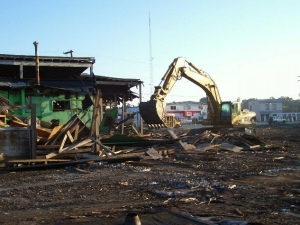
1. Acquiring the Necessary Permits
Before work on your demolition can begin, you’ll need to first acquire the necessary paperwork and permits. This step will likely include a site inspection as well.
2. Clear Out the Building
Some properties may come stripped down to the bare bones, but others could be homes or businesses still stocked with furniture. If you want to sell or reuse any of the items left behind, you’ll want to go in and remove them before the building is demolished. Any unwanted items can likely be demolished along with the building’s structure.You’ll want to get a sense of what items will be left by the seller as your project team is developing the schedule. The more items there are that you’d like to remove, the longer this step will take.
3. Put the Proper Safety Precautions into Place
All demolition safety plans should begin with a comprehensive site survey. They’ll evaluate the composition of the structure, and they’ll look for dangerous building materials, like lead, asbestos and other hazardous materials.Your team will then develop a plan specific to your site. This should include precautions for the safety of workers as well as the public.
4. Begin Demolition
Once the building is cleared and the safety plan is in place, your contractor can begin demolition. The tools and methods used to complete the work will vary based on the size and composition of the building.For interior demolitions, a crew will come in with hand-held tools. For bringing down an entire building, heavy equipment and construction machinery can be used, as well as controlled blasts.
5. Debris Removal
Once the demolition is complete, your team will start removing or repurposing the debris. If the demolished building was made of concrete or masonry, the structure can be broken down and reused. Larger pieces may be crushed up and potentially used as fill for paved areas.
How Much Does Building Demolition Cost?
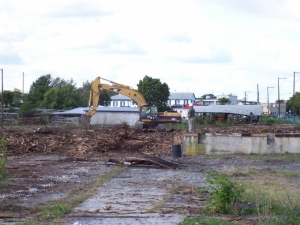
Location & Permits
In high-cost areas near large cities as well as the west and east coast, labor costs will be higher, and the costs to demolish a building will reflect that.Additionally, permit costs will vary depending on your township or city. These alone can range from a couple of hundred dollars to several thousand.
The Size of the Project
Large buildings will require more time and manpower to demolish. This translates to higher overall costs. However, you may find that the cost per square foot decreases the larger your demolition project is.
What the Building is Made Of
Some building materials are easier to tear down than others. For example, a concrete parking garage that’s only a few decades old will likely cost more to take down than an old farmhouse that’s been left to the elements for years.
Remediation & Hazardous Materials
Dealing with dangerous materials will require extra care and specialized expertise. If your building requires lead or asbestos removal during demolition, it will likely increase the cost.
Debris Disposal or Recycling
Once the building is knocked down, the debris needs to be collected and hauled away. There are a variety of ways this can happen, depending on the building that’s being demolished and your plans for the future of the lot. In some instances, the material can be recycled and used during the construction of your building or other buildings.
How Do I Find a Good Commercial Demolition Contractor?
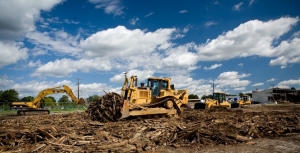
If you partner with a full-service excavating company, they’ll bring their full range of expertise to your project. With a wider breadth of experience, they’ll understand the ins and outs of demolition and its impact on your site as a whole. They can also complete site work for the new building, underground utility installation, and other services needed to complete your project. This can save you significant time and headaches, eliminating the need for a separate contract.
When looking for a building demolition contractor, you’ll want to ensure they have relevant experience and a track record of satisfied customers. Check their online reviews and testimonials, as well as their websites for a look at their past projects.
Lastly, you’ll want to choose a company that is invested in the project’s big picture.
A demolition and excavating contractor sets the stage for the rest of your project. Issues during the early project stages can derail the schedule and/or budget. By selecting a trusted and experienced excavation partner, your project can hit the ground running and be set for success from day one.
Posted January 06, 2022

